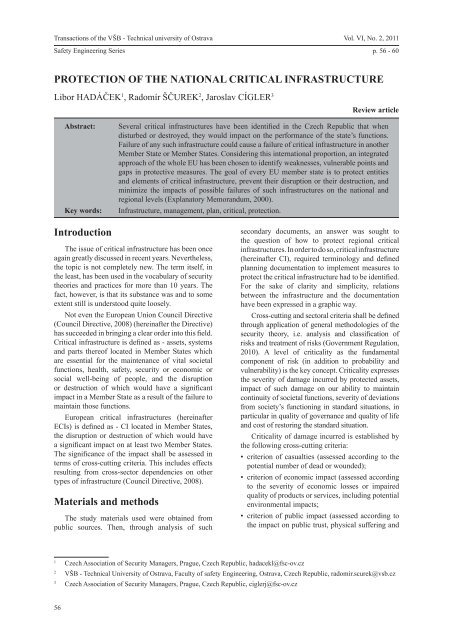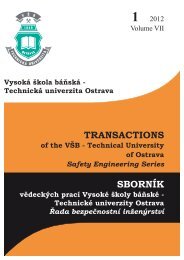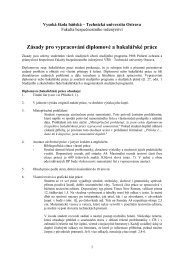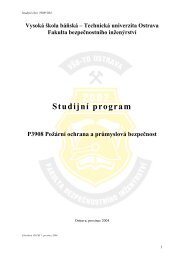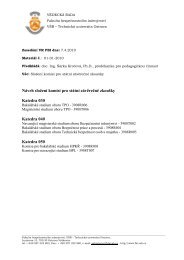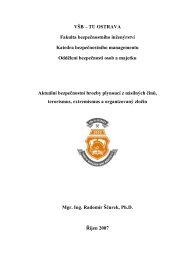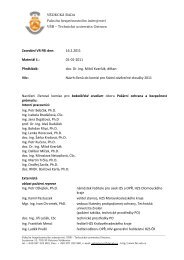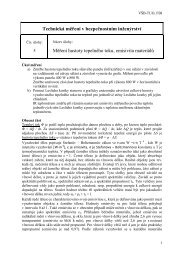Transactions - FBI - Vysoká Å¡kola báÅská - Technická univerzita ...
Transactions - FBI - Vysoká Å¡kola báÅská - Technická univerzita ...
Transactions - FBI - Vysoká Å¡kola báÅská - Technická univerzita ...
Create successful ePaper yourself
Turn your PDF publications into a flip-book with our unique Google optimized e-Paper software.
<strong>Transactions</strong> of the VŠB - Technical university of OstravaSafety Engineering SeriesVol. VI, No. 2, 2011p. 56 - 60PROTECTION OF THE NATIONAL CRITICAL INFRASTRUCTURELibor HADÁČEK 1 , Radomír ŠČUREK 2 , Jaroslav CÍGLER 3Review articleAbstract:Key words:Several critical infrastructures have been identified in the Czech Republic that whendisturbed or destroyed, they would impact on the performance of the state’s functions.Failure of any such infrastructure could cause a failure of critical infrastructure in anotherMember State or Member States. Considering this international proportion, an integratedapproach of the whole EU has been chosen to identify weaknesses, vulnerable points andgaps in protective measures. The goal of every EU member state is to protect entitiesand elements of critical infrastructure, prevent their disruption or their destruction, andminimize the impacts of possible failures of such infrastructures on the national andregional levels (Explanatory Memorandum, 2000).Infrastructure, management, plan, critical, protection.IntroductionThe issue of critical infrastructure has been onceagain greatly discussed in recent years. Nevertheless,the topic is not completely new. The term itself, inthe least, has been used in the vocabulary of securitytheories and practices for more than 10 years. Thefact, however, is that its substance was and to someextent still is understood quite loosely.Not even the European Union Council Directive(Council Directive, 2008) (hereinafter the Directive)has succeeded in bringing a clear order into this field.Critical infrastructure is defined as - assets, systemsand parts thereof located in Member States whichare essential for the maintenance of vital societalfunctions, health, safety, security or economic orsocial well-being of people, and the disruptionor destruction of which would have a significantimpact in a Member State as a result of the failure tomaintain those functions.European critical infrastructures (hereinafterECIs) is defined as - CI located in Member States,the disruption or destruction of which would havea significant impact on at least two Member States.The significance of the impact shall be assessed interms of cross-cutting criteria. This includes effectsresulting from cross-sector dependencies on othertypes of infrastructure (Council Directive, 2008).Materials and methodsThe study materials used were obtained frompublic sources. Then, through analysis of suchsecondary documents, an answer was sought tothe question of how to protect regional criticalinfrastructures. In order to do so, critical infrastructure(hereinafter CI), required terminology and definedplanning documentation to implement measures toprotect the critical infrastructure had to be identified.For the sake of clarity and simplicity, relationsbetween the infrastructure and the documentationhave been expressed in a graphic way.Cross-cutting and sectoral criteria shall be definedthrough application of general methodologies of thesecurity theory, i.e. analysis and classification ofrisks and treatment of risks (Government Regulation,2010). A level of criticality as the fundamentalcomponent of risk (in addition to probability andvulnerability) is the key concept. Criticality expressesthe severity of damage incurred by protected assets,impact of such damage on our ability to maintaincontinuity of societal functions, severity of deviationsfrom society’s functioning in standard situations, inparticular in quality of governance and quality of lifeand cost of restoring the standard situation.Criticality of damage incurred is established bythe following cross-cutting criteria:• criterion of casualties (assessed according to thepotential number of dead or wounded);• criterion of economic impact (assessed accordingto the severity of economic losses or impairedquality of products or services, including potentialenvironmental impacts;• criterion of public impact (assessed according tothe impact on public trust, physical suffering and1Czech Association of Security Managers, Prague, Czech Republic, hadacekl@fsc-ov.cz2VŠB - Technical University of Ostrava, Faculty of safety Engineering, Ostrava, Czech Republic, radomir.scurek@vsb.cz3Czech Association of Security Managers, Prague, Czech Republic, ciglerj@fsc-ov.cz56


